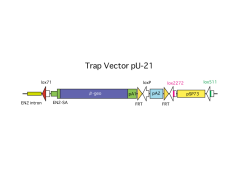Database for the Exchangeable Gene Trap Clones (EGTC)
 The gene trap technique is a powerful approach for characterizing and mutating genes involved in mouse development. However, one shortcoming of gene trapping is the relative inability to induce subtle mutations.
The gene trap technique is a powerful approach for characterizing and mutating genes involved in mouse development. However, one shortcoming of gene trapping is the relative inability to induce subtle mutations.
We have overcome this problem by introducing a knock-in system in the gene trap strategy and established the exchangeable gene trap vector, pU-Hachi, employing the Cre-mutated lox system.
[Kimi ARAKI, Masatake ARAKI and Ken-ichi Yamamura, Targeted integration of DNA using mutant lox sites in embryonic stem cells. Nucl. Acids Res., 25, 868-872 (1997).]
Since we found that there are some limitations in replacing patterns in pU-Hachi, we have constructed new version of gene trap vectors, pU-21, pU-21B, pU-21T, pU-18, pU-22 and pU-21W.
Although the number of analyzed trap clones is not so many compared with the other member of IGTC, all EGTC cell lines have been confirmed for single copy integration and presence of the lox71 site and the lox2272 site.
Concerning for 5'-RACE results, we have also checked fusion mRNA of the trapped gene and reporter gene by RT-PCR using gene specific sense primer and the antisense primer locating outside of RT primer used for RACE reaction.
In addition, mouse lines have been established from most of trap clones in this database and deposited to the CARD R-BASE; the database for cryopreserved embryos. Therefore, the trap lines can be provided in mouse or frozen embryos or sperm.
EGTC staff
 Kimi ARAKI, Yuko TSURUTA, Yumi SAKUMURA, Mayumi MUTA, Takako KEITA, Narumi KOGA, Toshiko EGAMI, Yoko KIMACHI, Yoko MINE, Kumiko MURAKAMI, Rie MINATO, Keika SAITO, Yuri KITAMOTO, Runa IKEDA, Mai NAKAHARA, Miharu Nishimura, Yosei ITO, Kumiko YOSHINOBU, Ken-ichi YAMAMURA, Masatake ARAKI.
Kimi ARAKI, Yuko TSURUTA, Yumi SAKUMURA, Mayumi MUTA, Takako KEITA, Narumi KOGA, Toshiko EGAMI, Yoko KIMACHI, Yoko MINE, Kumiko MURAKAMI, Rie MINATO, Keika SAITO, Yuri KITAMOTO, Runa IKEDA, Mai NAKAHARA, Miharu Nishimura, Yosei ITO, Kumiko YOSHINOBU, Ken-ichi YAMAMURA, Masatake ARAKI.
(Institute of Resource Development and Analysis, Kumamoto University)